Today’s Social Donors – 10 Facts Every Nonprofit Needs to Know
OneCause recently conducted an online survey 1,026 self-reported Social Donors who had donated to a fundraising event or peer-to-peer campaign within the last 12 months.
The purpose was to study the giving behaviors and motivators of social giving during the pandemic, and help nonprofits learn what worked and where we can improve, as we emerge from COVID-19.
In a year where people were forced to be apart, nonprofits found new and innovative ways to bring their communities together and maintain strong social connections with new and existing supporters. What did we discover? Let’s dive into 10 facts every nonprofit needs to know about today’s Social Donors. Specifically, who they are and what makes them tick!
- Social Donors Are Eager to Show Their Support
- Occasion and Challenge Campaigns Are on The Rise
- You Can Empower Your Donors to Raise More and Reach More
- Social Giving Attracts Younger, More Diverse Donors
- Generations Have Different Giving Patterns
- Millennials Emerged as the Caretaker During the Pandemic
- Social Giving Engages First-Time & Lapsed Donors
- Know What Motivates First Time Donors
- Ease, Mission, & Impact Drive Social Giving
- Social Donors Are Ready to Go Back In-Person Soon
1. Social Donors are Eager to Show Their Support
Approximately 27% of U.S. adults self-identify as a Social Donor, up from 23% reported in the 2018 Social Donor Study.
Support from donors is always needed to sustain nonprofits, but it is particularly critical in times of crisis. Now more than ever, Social Donors are supporting organizations who reached them virtually, online, and through digital channels. Innovative nonprofits who tried new campaigns, virtual events, and online giving opportunities were and will continue to be rewarded by these committed donors.
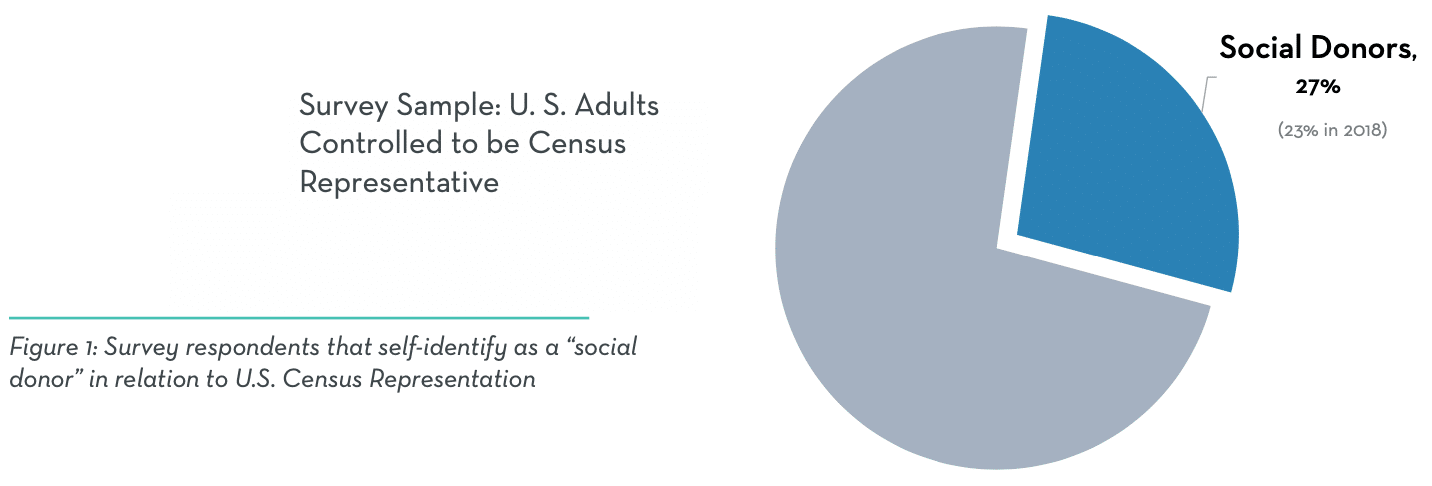

Even after the pandemic recedes, don’t be afraid to tap into these donors – whether it’s through giving days, awareness campaigns, DIY events, volunteer opportunities, or using social media to spread the word about your cause. This army of energized givers is waiting to connect with you!
Today’s Social Donors are eager to give. Why? Because your mission matters now more than ever. Be sure the story behind your nonprofit’s ‘why’ is strong and have a clear call to action. When you’re able to communicate the need and the impact, that’s when you’ll see the most success in your proceeds.
2. Occasion and Challenge Campaigns Are on The Rise
When we look at how these Social Donors give, we find their participation in fundraising events and runs, walks, rides remained consistent from 2018. The biggest area of growth was in giving to occasion/challenge campaigns – almost doubling the percentage of U.S. adults giving in this way over the last 12 months.
So… get creative! Diversify your fundraising online and make sure you have giving days, awareness campaigns, and evergreen DIY strategies worked into your fundraising calendar.
If you have your traditional gala or run, walk, or ride nailed down, think about how you can incorporate easy-to-launch online fundraising campaigns throughout the year. They’re the perfect avenue to engage your base and reach a new group of supporters.
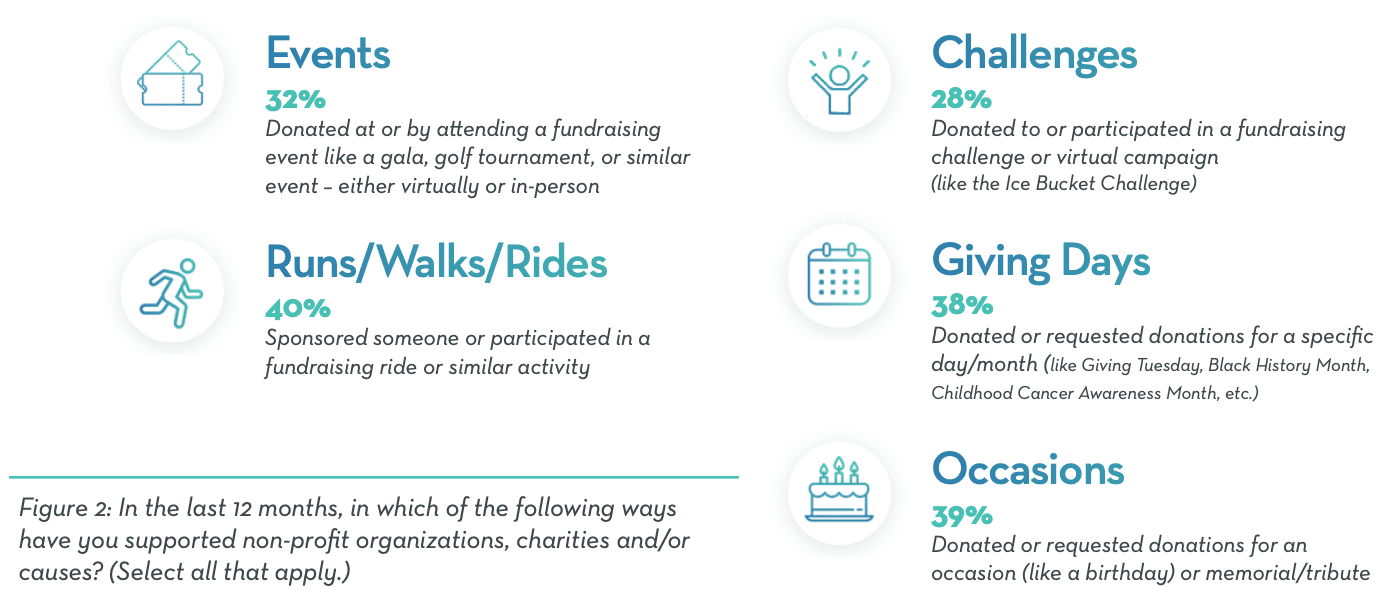

Social Donors are ready to be your cause’s champion! There was significant growth in Social Donors participating in occasions and challenges. This shows a shift in giving behaviors AND a huge opportunity for nonprofits. The surge in personalized giving means nonprofits need to continue to:
- Find ways for donors to Fundraise Your Way.
- Offer unique giving campaigns to tap into donor passions and social networks.
- Make it easy for supporters to spring up campaigns.
- Ensure birthdays, gifts in honor of a friend/family member, or viral giving moment like the Ice Bucket Challenge are not just part of your strategy, but on your website, social channels, and in communications.
Be sure to think out of the box on how you embrace occasion and challenge giving. Then equip them with the resources, technology, and knowledge to fundraise for you. It will maximize your reach and your proceeds as a result.
Speaking of getting creative – check out how WellAware empowered and motivated and army of Social Donors in their ShowerStrike campaign.
3. You Can Empower Your Donors to Raise More and Reach More
Donors are more than 2x as likely to hear about a social giving opportunity through a friend, family member, or colleague than from a nonprofit directly. Social networks are critical to the success of any event-based or peer-to-peer fundraising campaign.
There are opportunities to leverage social connections in post-giving touch points to drive additional donations and retention. Here are a few tips:
- Find ways to cultivate connections with new donors.
- Personalize thank you’s and messages from your nonprofit.
- Encourage those soliciting on your behalf to personally thank their supporters.
- Share the impact of their gifts on multiple channels for greatest reach (social, email, website).
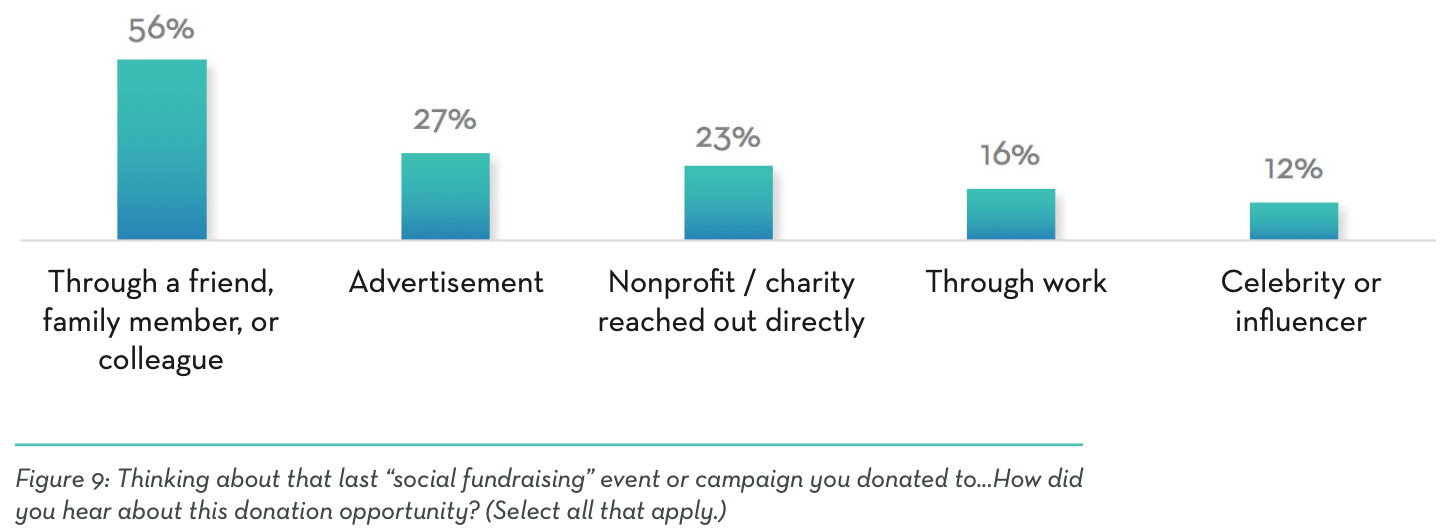

Giving is very personal, so it makes sense that donors are most likely to hear about a nonprofit’s mission through friends and family. It’s important to arm the ambassadors for your cause with templates and technology that make it easy for them to share, thank, and further communicate with donors they engage. Here are a few ideas to keep in mind:
- Sample email templates
- Promotional materials
- Social media recruitment posts
- Social integration from your peer-to-peer technology
- Donation talk tracks or donation solicitation emails
- Automated notifications when a new participant joins the campaign or their team
Social Giving Attracts Younger, More Diverse Donors
The data suggests that social giving is improving access to philanthropy. Gen Z and Millennials now represent a majority of Social Donors and participate in social giving at higher rates than their older peers. Giving through events and peer-to-peer fundraising is also increasing among Black and Hispanic donors.
Going virtual removed barriers to entry for those who previously couldn’t or chose to not attend in-person events, such as ticket sales and geographic location. With these events moving online, it opened up an easy avenue to giving. All great signs for increased giving from a wider segment of today’s donor population!


Younger donors have unique giving behaviors that are changing the way organizations approach fundraisers, from the onsite activities to the pre and post event engagement. A more diverse donor base means there’s a need for:
- Segmented communications
- Understanding donor personas, and
- New channels for engagement opportunities.
Be sure that as your donors are changing, so are your approaches and strategies!
Generations Have Different Giving Patterns
Good news! Total charitable donations from Millennials continue to rise, on par with Boomers and Matures. Millennials are also giving higher average donations to social giving events and campaigns compared to all other generations. When we took a look at what types of nonprofit organizations the different generations are giving to, here’s what we find:
- Gen X and Boomers’ top nonprofit type to donate to was Health related, followed by Animal Rescue and Faith-based organizations.
- Gen X and Boomers also support Children’s Charities and Social Services Organizations.
- Gen Z and Millennials on the other hand are more likely to look at current events to determine where to focus their donations – such as Human Rights.
- Gen Z and Millennials also support Children’s Charities and Health related organizations, similar to Gen X and Boomers.


Every generation differs in how they give, how much they give, and what causes they care about. Understand what generation the majority of your target audience falls under and tailor your fundraising approach to them!
Millennials Emerged as the Caretaker During the Pandemic
Millennials emerged as the caretaker of nonprofits during the pandemic, as they were more likely to donate to sustain an organization through COIVD-19.
This generation is the largest group of up-and-coming donors the industry has ever seen. They are also more digital savvy than any generation of donors before them. It’s important for nonprofits to spend the time and attention to make sure that the online giving experience is as easy and simple as possible.
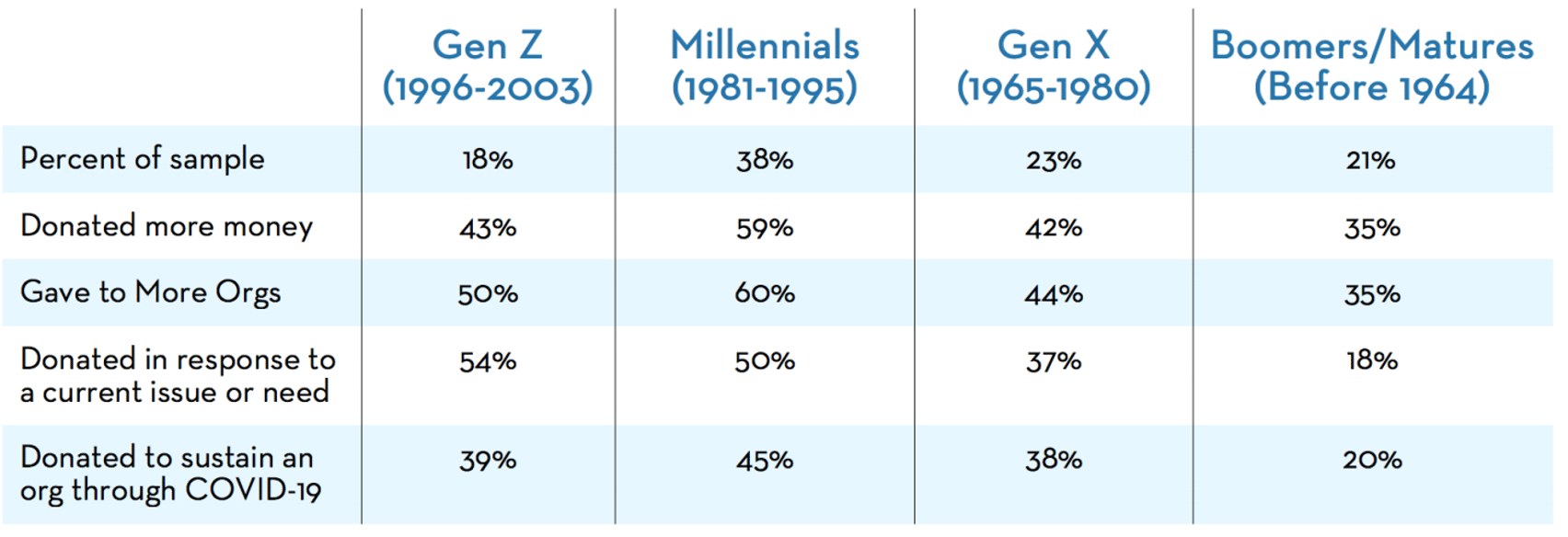

Be sure you have a strong strategy for how you’re going to engage your Millennial donors – including personalized marketing tactics, an easy online giving experience, and a way to communicate impact.
Social Giving Engaged First-Time & Lapsed Donors
Social giving experiences over the past year have been an opportunity for nonprofits to attract first-time donors and reengage lapsed donors. The accessibility of virtual fundraising played an important part in expanding reach into new bases and dormant donor groups.
This is very promising for nonprofits!
But what about retaining these first-time donors? The three biggest factors impacting repeat donations from first-time donors include:
- Feeling like their donation made a difference
- Having a positive and easy donation experience, and
- Being asked to donate again by someone they know.
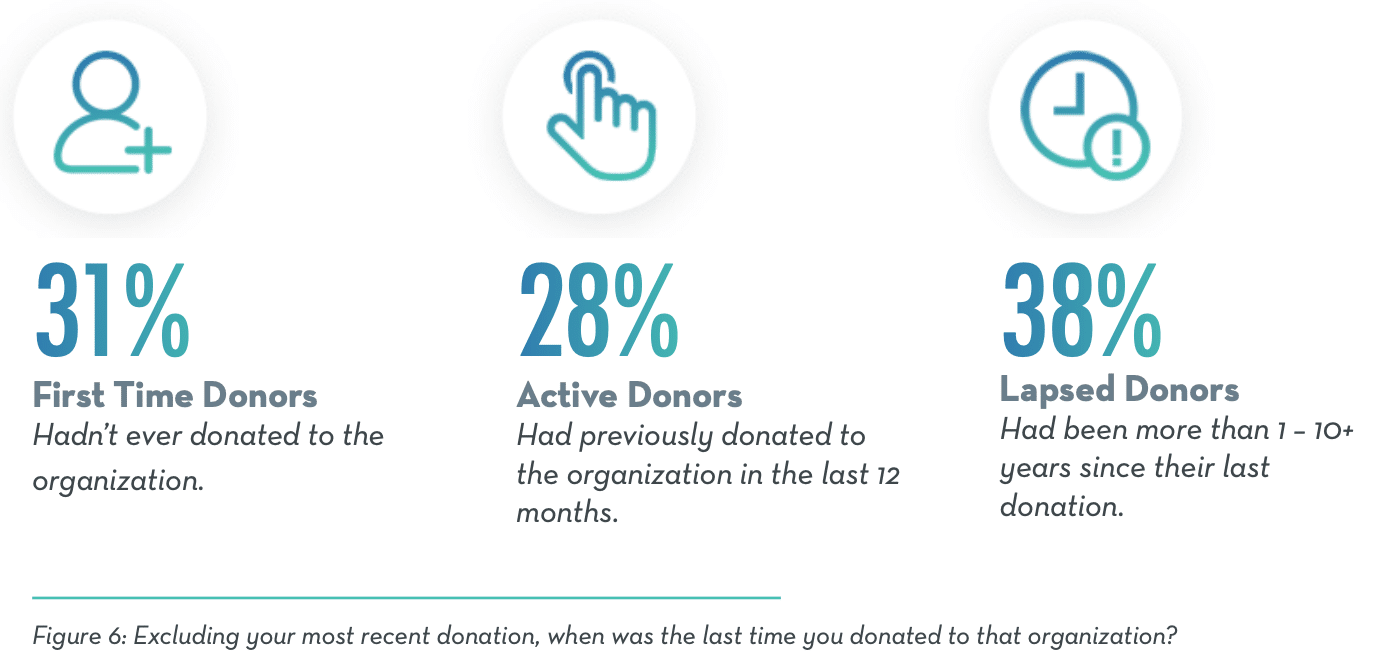

One of the most common mistakes is not doing enough to maintain strong connections. If you want your donors to return again and again to support your campaigns, focus on what keeps them coming back – and do more of it!
Know What Motivates First Time Donors
In addition to the top motivators – ease, mission, and impact – first-time donors are also motivated by:
- Wanting to support the person who asked them to donate,
- Caring about that person over the cause, and
- Knowing how their donation would be used.
Interestingly, only 30% of first-time donors said they were motivated to give to sustain an organization through COVID-19.
Nonprofits should remember that new donors don’t have the same background and familiarity as existing donors. First-time donors need more mission connection, impact statements, and inspiration to capture their donations.
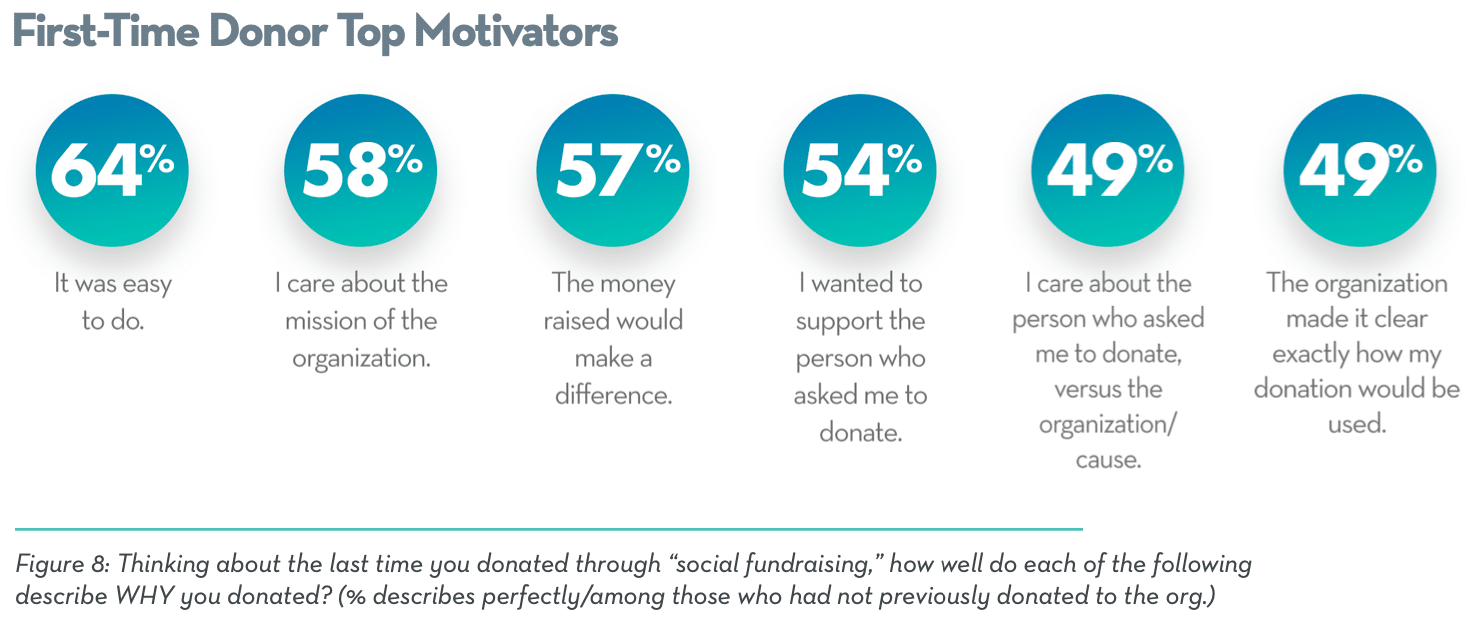

While ease, mission, and impact remain important, first-time donors are also motivated by the person asking for their donation. If you have donors, volunteers, or board members who are advocates for your cause, empower and equip them to reach out to first-time donors and motivate giving!
Ease, Mission, & Impact Drive Social Giving
Across all demographics, the top reasons why people give have remained the same since 2018.
- It was easy to do.
- I care about the mission of the organization.
- The money raised would make a difference.
Ease, mission, and impact – the secret recipe to creating a strong giving experience! These core motivators are consistent whether someone is a regular donor or making their first donation to an organization.
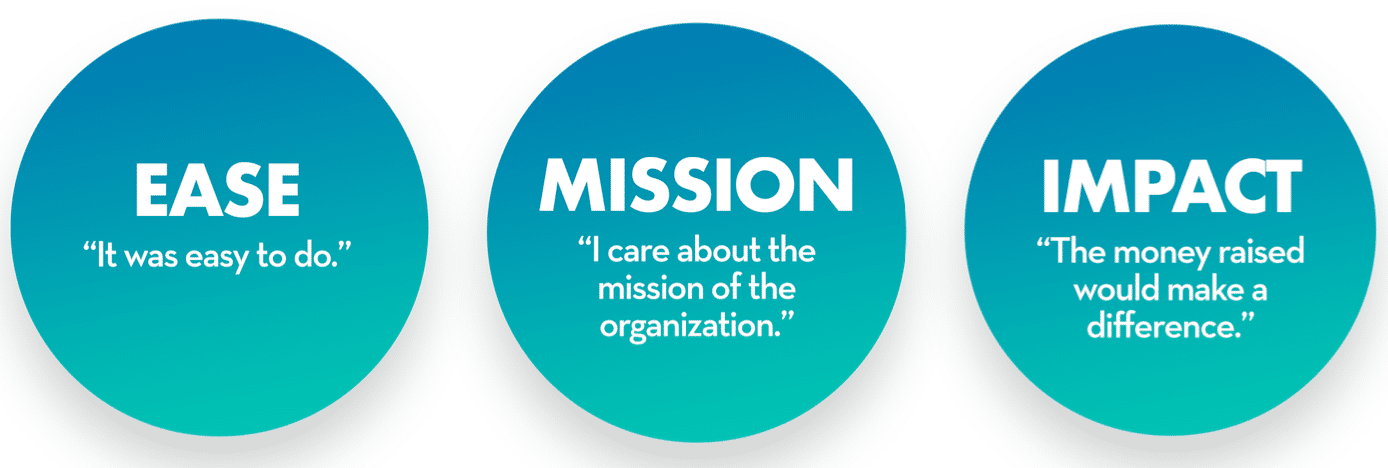

Social Donors want their giving to be easy, so it’s time to examine your traditional and technology-based giving opportunities to ensure a seamless experience. They also want to understand how their donation will make a difference. That means a nonprofit’s mission, impact, and reason for giving needs to be at the forefront of any message in order to engage Social Donors.
Social Donors Are Ready to Go Back In-Person Soon
The majority of donors surveyed said they are ready to return to in-person events in 2021. Some of the biggest factors impacting their decision to attend an in-person event center around vaccinations.
- I would need to be vaccinated – 51%
- My household/family would need to be vaccinated – 36%
- All event attendees would need to be vaccinated – 35%
At the time of this survey in April 2021, 55% of those who responded stated they were vaccinated, with an additional 31% planning to get vaccinated. Event size and travel restrictions are not important deciding factors for the majority of those surveyed.


In person fundraising events are coming and your donors are most likely ready! Be sure that you are staying up to date on all CDC guidelines, taking into account safety and social distancing at all aspects of your event, and listening to what your donor base is most comfortable with.
Putting the Data to Work
Now that you have the basics on Social Donors, it’s time to think about how to incorporate them into your development strategy. Here’s four simple tips your nonprofit can take to create a Social Donor fundraising plan:
- Review the OneCause Social Donor Research Study. It is full of rich data and actionable recommendations. Download the study here.
- Analyze Your Social Donor Base. Look at your events and peer-to-peer campaigns and segment your donors by giving experience type. Where did they come from? How can you continue to engage them?
- Create Social Donor Personas. Create new donor personas with Social Donors in mind. What key characteristics of your donors can you tap into to create a positive giving experience for them?
- Map Annual Giving Opportunities. Take your fundraising calendar and map out which events, campaigns, and challenges would appeal to Social Donors.